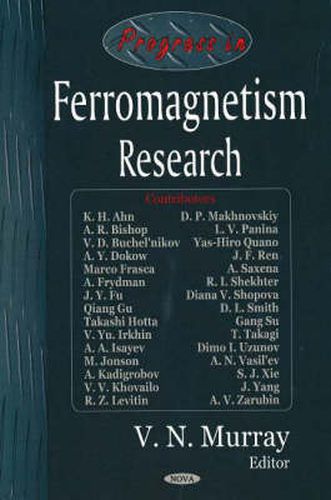Readings Newsletter
Become a Readings Member to make your shopping experience even easier.
Sign in or sign up for free!
You’re not far away from qualifying for FREE standard shipping within Australia
You’ve qualified for FREE standard shipping within Australia
The cart is loading…






Ferromagnetism is a form of magnetism that can be acquired in an external magnetic field and usually retained in its absence, so that ferromagnetic materials are used to make permanent magnets. A ferromagnetic material may therefore be said to have a high magnetic permeability and susceptibility (which depends upon temperature). Examples are iron, cobalt, nickel, and their alloys. Ultimately, ferromagnetism is caused by spinning electrons in the atoms of the material, which act as tiny weak magnets. They align parallel to each other within small regions of the material to form domains, or areas of stronger magnetism. In an unmagnetised material, the domains are aligned at random so there is no overall magnetic effect. If a magnetic field is applied to that material, the domains align to point in the same direction, producing a strong overall magnetic effect. Permanent magnetism arises if the domains remain aligned after the external field is removed. Ferromagnetic materials exhibit hysteresis. In 2004, it was discovered that a certain allotrope of carbon, nanofoam , exhibited ferromagnetism. The effect dissipates after a few hours at room temperature, but lasts longer at cold temperatures. The material is also a semiconductor. It is thought that other similarly formed materials, of boron and nitrogen, may also be ferromagnetic. This new book rings together leading research from throughout the world.
$9.00 standard shipping within Australia
FREE standard shipping within Australia for orders over $100.00
Express & International shipping calculated at checkout
Ferromagnetism is a form of magnetism that can be acquired in an external magnetic field and usually retained in its absence, so that ferromagnetic materials are used to make permanent magnets. A ferromagnetic material may therefore be said to have a high magnetic permeability and susceptibility (which depends upon temperature). Examples are iron, cobalt, nickel, and their alloys. Ultimately, ferromagnetism is caused by spinning electrons in the atoms of the material, which act as tiny weak magnets. They align parallel to each other within small regions of the material to form domains, or areas of stronger magnetism. In an unmagnetised material, the domains are aligned at random so there is no overall magnetic effect. If a magnetic field is applied to that material, the domains align to point in the same direction, producing a strong overall magnetic effect. Permanent magnetism arises if the domains remain aligned after the external field is removed. Ferromagnetic materials exhibit hysteresis. In 2004, it was discovered that a certain allotrope of carbon, nanofoam , exhibited ferromagnetism. The effect dissipates after a few hours at room temperature, but lasts longer at cold temperatures. The material is also a semiconductor. It is thought that other similarly formed materials, of boron and nitrogen, may also be ferromagnetic. This new book rings together leading research from throughout the world.